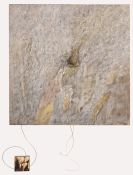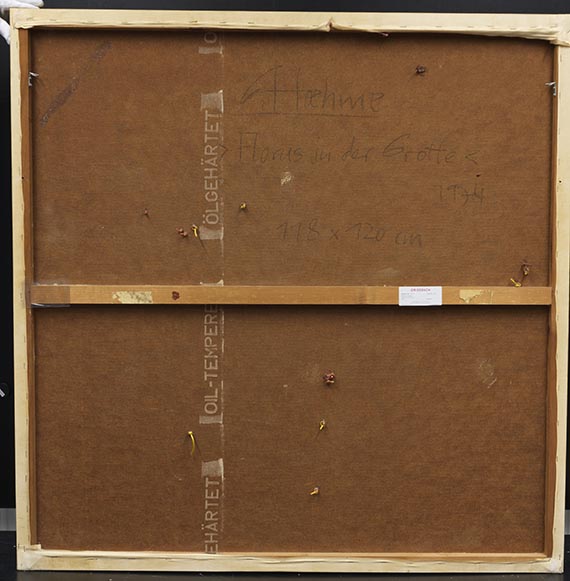Gerhard Hoehme
Florus in der Grotte, 1974
Acrylic
Current bid:
€ 8,000 Estimate:
€ 8,000End: 12-15-24 16:05:00 Berlin
12-15-24 10:05:00 New York
12-15-24 07:05:00 Los Angeles (22 days, 01h:06m)
12-15-24 10:05:00 New York
12-15-24 07:05:00 Los Angeles (22 days, 01h:06m)
After entering your maximum bid you will be able to check your entry and you will be provided with further information. Only after a further confirmation your bid will be binding.
Lot description
Florus in der Grotte. 1974.
Acrylic on Damask over fiberboard with PE strings.
Signed and dated in lower left. Signed, dated, titled and inscribed on the everse. 118 x 117 x 10.5 cm (46.4 x 46 x 4.1 in). [JS].
• Hoehme's work is a fascinating contribution to a new pictorial concept that is liberated from the traditional confines of painting.
• In his famous works with plastic strings, Hoehme expands the picture plane into the third dimension and allows the surface to protrude into the surrounding space.
• Hoehme's progressive visual concept is characterized by a fascinating non-conformity and vibrancy.
• Hoehme'smultifaceted oeuvre has been honored with major exhibitions at, among others, the Museum am Ostwall in Dortmund (1980), the Städtische Kunsthalle Mannheim (1985/86), the Kunsthalle Düsseldorf (2000) and the MKM Museum Küppersmühle (2009/10).
PROVENANCE: Private collection Germany.
Private collection Rhineland (since 1983, inherited from the above).
LITERATURE: Margarete Hoehme, Kunstmuseum Bonn, Dieter Ronte und Christoph Schreier (eds.), Gerhard Hoehme. Catalogue Raisonné, Bonn 1998, p. 340, no. 74-06 (not illustrated).
"Art scholars will have a hard time with my work [..]"
(Gerhard Hoehme, quoted from Margarete Hoehme et al (ed.), Gerhard Hoehme. Catalogue Raisonné, Bonn 1998, p. 47)
With roots in Informalism in the 1950s, Hoehme produced a highly diverse body of work over the following decades, that is the result of a continuous artistic quest to transcend the boundaries of painting. As early as 1957, Hoehme expressed this strong desire in the following words: "I have always been reluctant to follow the laws of the surface. [.] I longed for the wide open space, the third, fourth, fifth - upwards, sideways, forwards, even backwards, but without any illusionistic depth. One day I stopped mounting the canvas on the stretcher and did the opposite: I took a large piece of canvas and used it as a field on which the events could unfold. (quoted from: G. Hoehme. Catalogue Raisonné, p. 506). It was from this endeavor that Hoehme's irregular canvas formats emerged as early as the 1950s, an important artistic step towards a painting beyond boundaries, which would only gain art historical significance in the 1960s through Frank Stella's "shaped canvases". Hoehme's language and text pictures from around 1960 show a closeness to the contemporaneous creations of the American Cy Twombley. The stylistic proximity of these two artists was, however, only short-lived: Hoehme soon turned to pattern sheets and string pictures in his search for the maximum delimitation of the image, and by incorporating unfamiliar materials and long PVC strings that extended the canvas into thesurrounding space, he soon overcame the traditional boundaries of panel painting. From the 1960s onwards, Hoehme held a professorship at the Düsseldorf Art Academy alongside Joseph Beuys and Sigmar Polke was among his students. The present composition "Florus in der Grotte" (Florus in the Grotto) is a particularly beautiful example of Hoeme's progressive act of allowing plastic strings to grow out of the surface, a trademark he developed in the second half of the 1960s. The combination of the finely accentuated materiality of the damask, the painting and the three-dimensional elements of the looped and winding PE strings is fascinating. Hoehme's oeuvre relentlessly questions the traditional boundaries of painting, thus creating a fascinating body of works characterized by an uncompromising desire for boundlessness. [JS]
Good overall impression. The damask is slightly unevenly discolored due to the material quality and the technique, as well as with a few isolated tiny brown spots and moisture stains. Edges partially minimally unfresh or rubbed. PE strings slightly discolored due to aging. The condition report was compiled in daylight with the help of an ultraviolet light and to the best of our knowledge.
Acrylic on Damask over fiberboard with PE strings.
Signed and dated in lower left. Signed, dated, titled and inscribed on the everse. 118 x 117 x 10.5 cm (46.4 x 46 x 4.1 in). [JS].
• Hoehme's work is a fascinating contribution to a new pictorial concept that is liberated from the traditional confines of painting.
• In his famous works with plastic strings, Hoehme expands the picture plane into the third dimension and allows the surface to protrude into the surrounding space.
• Hoehme's progressive visual concept is characterized by a fascinating non-conformity and vibrancy.
• Hoehme'smultifaceted oeuvre has been honored with major exhibitions at, among others, the Museum am Ostwall in Dortmund (1980), the Städtische Kunsthalle Mannheim (1985/86), the Kunsthalle Düsseldorf (2000) and the MKM Museum Küppersmühle (2009/10).
PROVENANCE: Private collection Germany.
Private collection Rhineland (since 1983, inherited from the above).
LITERATURE: Margarete Hoehme, Kunstmuseum Bonn, Dieter Ronte und Christoph Schreier (eds.), Gerhard Hoehme. Catalogue Raisonné, Bonn 1998, p. 340, no. 74-06 (not illustrated).
"Art scholars will have a hard time with my work [..]"
(Gerhard Hoehme, quoted from Margarete Hoehme et al (ed.), Gerhard Hoehme. Catalogue Raisonné, Bonn 1998, p. 47)
With roots in Informalism in the 1950s, Hoehme produced a highly diverse body of work over the following decades, that is the result of a continuous artistic quest to transcend the boundaries of painting. As early as 1957, Hoehme expressed this strong desire in the following words: "I have always been reluctant to follow the laws of the surface. [.] I longed for the wide open space, the third, fourth, fifth - upwards, sideways, forwards, even backwards, but without any illusionistic depth. One day I stopped mounting the canvas on the stretcher and did the opposite: I took a large piece of canvas and used it as a field on which the events could unfold. (quoted from: G. Hoehme. Catalogue Raisonné, p. 506). It was from this endeavor that Hoehme's irregular canvas formats emerged as early as the 1950s, an important artistic step towards a painting beyond boundaries, which would only gain art historical significance in the 1960s through Frank Stella's "shaped canvases". Hoehme's language and text pictures from around 1960 show a closeness to the contemporaneous creations of the American Cy Twombley. The stylistic proximity of these two artists was, however, only short-lived: Hoehme soon turned to pattern sheets and string pictures in his search for the maximum delimitation of the image, and by incorporating unfamiliar materials and long PVC strings that extended the canvas into thesurrounding space, he soon overcame the traditional boundaries of panel painting. From the 1960s onwards, Hoehme held a professorship at the Düsseldorf Art Academy alongside Joseph Beuys and Sigmar Polke was among his students. The present composition "Florus in der Grotte" (Florus in the Grotto) is a particularly beautiful example of Hoeme's progressive act of allowing plastic strings to grow out of the surface, a trademark he developed in the second half of the 1960s. The combination of the finely accentuated materiality of the damask, the painting and the three-dimensional elements of the looped and winding PE strings is fascinating. Hoehme's oeuvre relentlessly questions the traditional boundaries of painting, thus creating a fascinating body of works characterized by an uncompromising desire for boundlessness. [JS]
Good overall impression. The damask is slightly unevenly discolored due to the material quality and the technique, as well as with a few isolated tiny brown spots and moisture stains. Edges partially minimally unfresh or rubbed. PE strings slightly discolored due to aging. The condition report was compiled in daylight with the help of an ultraviolet light and to the best of our knowledge.
Gerhard Hoehme
Florus in der Grotte, 1974
Acrylic
Starting bid:
€ 8,000 Estimate
€ 8,000End: 12-15-24 16:05:00 Berlin
12-15-24 10:05:00 New York
12-15-24 07:05:00 Los Angeles (22 days, 01h:06m)
12-15-24 10:05:00 New York
12-15-24 07:05:00 Los Angeles (22 days, 01h:06m)
After entering your maximum bid you will be able to check your entry and you will be provided with further information. Only after a further confirmation your bid will be binding.
Similar objects on the international auction market

GERHARD HOEHME
Alcantara - Ätnabild, 1981
Acrylic on canvas, volcanic rock on plexiglass,...
Sold: € 36,250
Alcantara - Ätnabild, 1981
Acrylic on canvas, volcanic rock on plexiglass,...
Sold: € 36,250

GERHARD HOEHME
Discomath, 1978
Object
Sold: € 30,000
Discomath, 1978
Object
Sold: € 30,000





